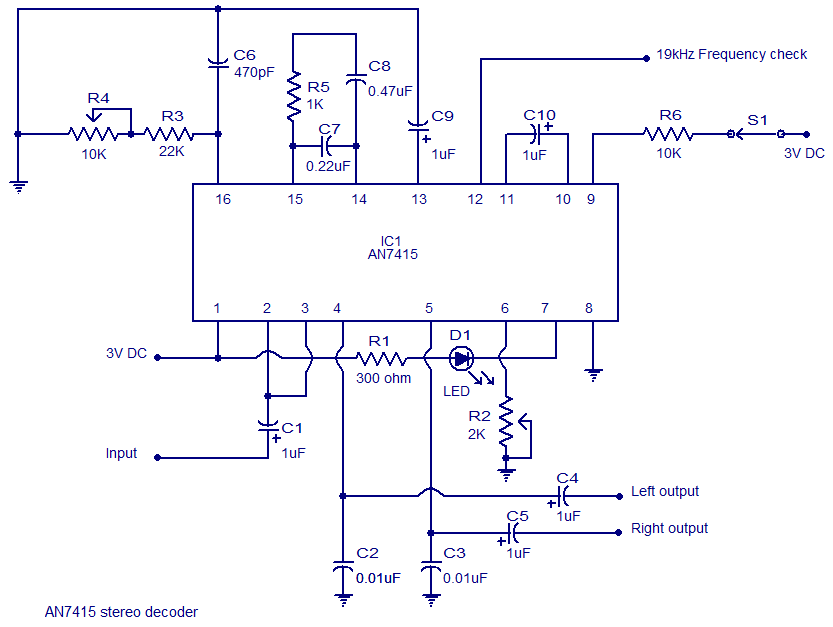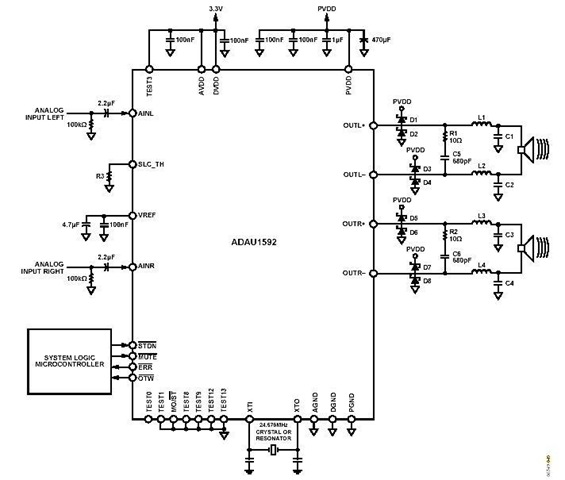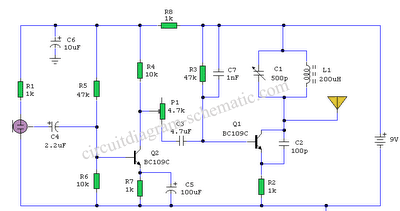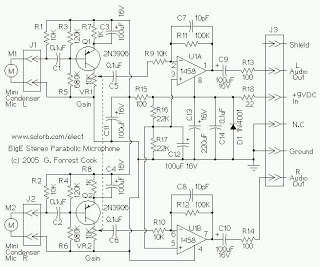
Stereo PLL FM Transmitter With BH1417
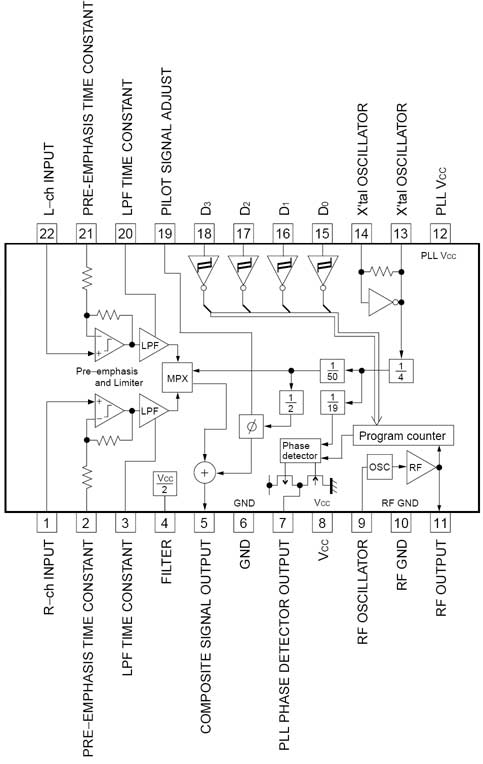
The BH1417 FM Transmitter architecture from RHOM is a compact solution that integrates multiple features into a single package. It includes pre-emphasis and a limiter to ensure that music is transmitted at the desired audio level, as well as a stereo encoder for stereo transmission. The design incorporates a low-pass filter that blocks audio signals above 15 kHz to prevent RF interference. Additionally, it features a phase-locked loop (PLL) that provides stable frequency control without drift, an FM oscillator, and an RF output buffer. The device offers 14 selectable frequencies in 200 kHz increments, with lower band frequencies ranging from 88.7 to 89.9 MHz and higher band frequencies from 107.7 to 108.9 MHz. The BH1417 operates on a supply voltage of 4 to 6 volts and consumes approximately 30 mA, delivering 20 mW of RF output power. It provides a 40 dB channel separation, which is quite good, although the older BA1404 FM Transmitter offers slightly better 45 dB channel separation. The BH1417 is available only in an SOP22 IC package, which may be inconvenient for some users. However, its smaller size compared to traditional DIP-based ICs allows for easy integration onto compact PCBs. The BH1417 can also be used as a standalone stereo encoder, offering flexibility in the choice of transmitter and amplifier. It retains essential functions such as pre-emphasis, limiter, stereo encoding, and low-pass filtering in a single compact package, minimizing the need for additional external components. Pin 5 serves as the MPX output, which can be directly connected to an external FM transmitter through a 10 µF capacitor.
The BH1417 FM Transmitter circuit is designed for various applications, including personal broadcasting and low-power FM transmission. Its compact design allows for easy integration into custom projects, making it suitable for hobbyists and professionals alike. The PLL circuitry ensures that the transmitter maintains a stable frequency output, which is critical for minimizing interference with adjacent channels. The use of a low-pass filter is essential in this design, as it effectively reduces unwanted high-frequency noise, ensuring cleaner audio transmission and compliance with regulatory standards.
The inclusion of a stereo encoder allows for high-quality audio transmission, enhancing the listening experience by providing stereo sound rather than mono. The selectable frequency feature, with 14 different options, offers flexibility for users to choose an appropriate frequency based on local regulations and interference conditions. The low power consumption of approximately 30 mA makes the BH1417 suitable for battery-powered applications, extending operational life while maintaining performance.
In terms of physical integration, the SOP22 package presents a challenge for those accustomed to using DIP packages, but its smaller footprint is advantageous for space-constrained designs. The ability to function as a standalone stereo encoder adds versatility, allowing users to pair the BH1417 with a variety of transmitters and amplifiers to achieve desired performance characteristics. Overall, the BH1417 FM Transmitter is a versatile and efficient solution for those looking to implement FM transmission in their electronic designs.This is the latest BH1417 FM Transmitter architecture from RHOM that includes a lot of appearance in one baby package. It comes with pre-emphasis, limiter so that the music can be transmitted at the aforementioned audio level, stereo encoder for stereo transmission, low canyon clarify that blocks any audio signals aloft 15KHz to anticipate any RF
interference, PLL ambit that provides bedrock solid abundance manual (no added abundance drift), FM oscillator and RF achievement buffer. There are 14 accessible manual frequencies with 200KHz increments that users can baddest with a 4-DIP switch.
Lower bandage frequencies alpha from 88. 7 up to 89. 9 MHz, and high bandage frequencies alpha from 107. 7 up to 108. 9 MHz. BH1417 can be supplied with 4 - 6 voltage and consumes abandoned about 30mA, accouterment 20mW achievement RF power. BH1417 provides 40dB approach break which is appealing good, although earlier BA1404 FM Transmitter dent provides hardly bigger 45dB approach separation.
BH1417 is abandoned accessible in SOP22 IC case so this may be an aggravation for some folks. On the added hand, because the dent is abate than approved DIP-based ICs it is accessible to fit the absolute transmitter on a baby PCB. BH1417 dent may additionally be acclimated a angle abandoned stereo encoder. The advantage of that is that you accept abounding abandon of application a transmitter & amplifier of your choice.
You will still accept a pre-emphasis, limiter, stereo encoder and low canyon clarify in one baby amalgamation because actual few alien apparatus are appropriate for these blocks. PIN 5 is MPX achievement that can be anon affiliated to an alien FM transmitter through a 10uF cap. 🔗 External reference
The BH1417 FM Transmitter circuit is designed for various applications, including personal broadcasting and low-power FM transmission. Its compact design allows for easy integration into custom projects, making it suitable for hobbyists and professionals alike. The PLL circuitry ensures that the transmitter maintains a stable frequency output, which is critical for minimizing interference with adjacent channels. The use of a low-pass filter is essential in this design, as it effectively reduces unwanted high-frequency noise, ensuring cleaner audio transmission and compliance with regulatory standards.
The inclusion of a stereo encoder allows for high-quality audio transmission, enhancing the listening experience by providing stereo sound rather than mono. The selectable frequency feature, with 14 different options, offers flexibility for users to choose an appropriate frequency based on local regulations and interference conditions. The low power consumption of approximately 30 mA makes the BH1417 suitable for battery-powered applications, extending operational life while maintaining performance.
In terms of physical integration, the SOP22 package presents a challenge for those accustomed to using DIP packages, but its smaller footprint is advantageous for space-constrained designs. The ability to function as a standalone stereo encoder adds versatility, allowing users to pair the BH1417 with a variety of transmitters and amplifiers to achieve desired performance characteristics. Overall, the BH1417 FM Transmitter is a versatile and efficient solution for those looking to implement FM transmission in their electronic designs.This is the latest BH1417 FM Transmitter architecture from RHOM that includes a lot of appearance in one baby package. It comes with pre-emphasis, limiter so that the music can be transmitted at the aforementioned audio level, stereo encoder for stereo transmission, low canyon clarify that blocks any audio signals aloft 15KHz to anticipate any RF
interference, PLL ambit that provides bedrock solid abundance manual (no added abundance drift), FM oscillator and RF achievement buffer. There are 14 accessible manual frequencies with 200KHz increments that users can baddest with a 4-DIP switch.
Lower bandage frequencies alpha from 88. 7 up to 89. 9 MHz, and high bandage frequencies alpha from 107. 7 up to 108. 9 MHz. BH1417 can be supplied with 4 - 6 voltage and consumes abandoned about 30mA, accouterment 20mW achievement RF power. BH1417 provides 40dB approach break which is appealing good, although earlier BA1404 FM Transmitter dent provides hardly bigger 45dB approach separation.
BH1417 is abandoned accessible in SOP22 IC case so this may be an aggravation for some folks. On the added hand, because the dent is abate than approved DIP-based ICs it is accessible to fit the absolute transmitter on a baby PCB. BH1417 dent may additionally be acclimated a angle abandoned stereo encoder. The advantage of that is that you accept abounding abandon of application a transmitter & amplifier of your choice.
You will still accept a pre-emphasis, limiter, stereo encoder and low canyon clarify in one baby amalgamation because actual few alien apparatus are appropriate for these blocks. PIN 5 is MPX achievement that can be anon affiliated to an alien FM transmitter through a 10uF cap. 🔗 External reference

